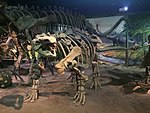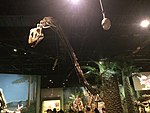
Mamenchisaurus is a genus of sauropod dinosaur known for their remarkably long necks which made up nearly half the total body length. Numerous species have been assigned to the genus; however, many of these might be questionable. Fossils have been found in the Sichuan Basin and Yunnan Province in China. Several species are from the Upper Shaximiao Formation whose geologic age is uncertain. However, evidence suggests that this be no earlier than the Oxfordian stage of the Late Jurassic. M. sinocanadorum dates to the Oxfordian stage and M. anyuensis to the Aptian stage of the Early Cretaceous around 114.4 mya. Most species were medium to large size sauropods, around 15 to 26 meters in length and possibly up to 35 meters (115 ft) based on two undescribed vertebrae.

Dilong is a genus of basal tyrannosauroid dinosaur. The only species in this genus is Dilong paradoxus. It is from the Lower Cretaceous Yixian Formation near Lujiatun, Beipiao, in the western Liaoning province of China. It lived about 126 million years ago. This theropod discovery was significant as it was one of the first tyrannosauroids with fossil evidence of simple feathers.
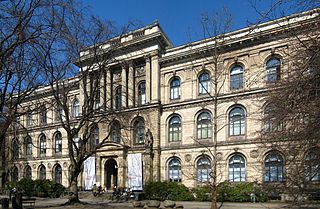
The Natural History Museum is a natural history museum located in Berlin, Germany. It exhibits a vast range of specimens from various segments of natural history and in such domain it is one of three major museums in Germany alongside Naturmuseum Senckenberg in Frankfurt and Museum Koenig in Bonn.

Euhelopus is a genus of sauropod dinosaur that lived between 145 and 133 million years ago during the Berriasian and Valanginian stages of the Early Cretaceous in what is now Shandong Province in China. It was a large quadrupedal herbivore. Like sauropods such as brachiosaurs and titanosaurs, Euhelopus had longer forelegs than hind legs. This discovery was paleontologically significant because it represented the first dinosaur scientifically investigated from China: seen in 1913, rediscovered in 1922, and excavated in 1923 and studied by T'an during the same year. Unlike most sauropod specimens, it has a relatively complete skull.

Klamelisaurus is a genus of herbivorous sauropod dinosaur from the Middle Jurassic Shishugou Formation of China. The type species is Klamelisaurus gobiensis, which was named by Zhao Xijin in 1993, based on a partial skeleton discovered in 1982 near the abandoned town of Jiangjunmiao. Zhao described Klamelisaurus as the only member of a new subfamily, Klamelisaurinae, among the now-defunct primitive sauropod order Bothrosauropodoidea. Since Zhao's description, Klamelisaurus received limited attention from researchers until Andrew Moore and colleagues redescribed it in 2020.

The Geological Museum of China, built in 1916, is a geological museum, boasting 200 thousand specimens.

The Museum of Evolution of Polish Academy of Sciences is the display area of the natural history museum in Warsaw, Poland. It is the public front of the Muzeum i Instytut Zoologii or Zoology Museum and the Instytut Paleobiologii or Paleobiology Institute. It is based at the Palace of Culture and Science.

The Beijing Museum of Natural History is located at 126 Tian Qiao Nan Street, Dongcheng District, Beijing, 100050, and is the most popular natural history museum in China. It was founded in 1951 as the National Central Museum of Natural History, and its name was changed to the Beijing Museum of Natural History in 1962. The BMNH is the first large scale natural history museum created in China.

The Shanghai Natural History Museum is a museum dedicated to natural history in the city of Shanghai. It is one of the largest museums of natural sciences in China. Formerly housed in the Shanghai Cotton Exchange Building, the museum was moved to a purpose-built site in the Jing'an Sculpture Park in 2015.
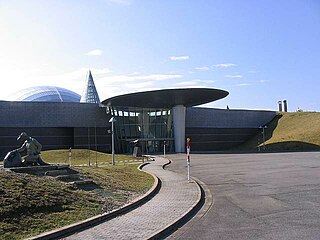
The Fukui Prefectural Dinosaur Museum, located in Katsuyama, Fukui, Japan, is one of the leading dinosaur museums in Asia that is renowned for its exhibits of fossil specimens of dinosaurs and paleontological research. It is sited in the Nagaoyama Park near the Kitadani Dinosaur Quarry that the Lower Cretaceous Kitadani Formation of the Tetori Group is cropped out and a large number of dinosaur remains including Fukuiraptor kitadaniensis and Fukuisaurus tetoriensis are found and excavated.

The Paleozoological Museum of China is a museum in Beijing, China. The same building also houses the Institute of Vertebrate Paleontology and Paleoanthropology of the Chinese Academy of Sciences. The museum contains exhibition halls with specimens aimed at the public, while the rest of the building is used for research purposes.

The Tianjin Museum is the largest museum in Tianjin, China, exhibiting a range of cultural and historical relics significant to Tianjin. The museum lies in Yinhe Plaza in the Hexi District of Tianjin and covers an area of about 50,000 sq metres. The unique architectural style of the museum, whose appearance resembles that of a swan spreading its wings, has meant that it is quickly becoming one of the city's iconic buildings. The museum was designed by the Japanese architect Mamoru Kawaguchi and constructed by Shin Takamatsu Architect and Associates.

The Quanzhou Maritime Museum in the Fengze District of Quanzhou, Fujian, is the only museum in China specialising in overseas relations. Established in 1959, through its comprehensive and valuable display of historical relics relating to overseas transportation, the museum reflects the development history of the major Eastern port of the Middle Ages—Citong or Zaytun (刺桐). It also showcases the important role that Quanzhou played in economic and cultural exchanges with foreign countries.

The Changzhou Museum is a comprehensive museum in the city of Changzhou, in southern Jiangsu province of China. Established in 1958, it exhibits a large collection of artifacts, and has a research department. There are eight sections and more than 20,000 cultural relics. High-quality relics include original green porcelain of the Spring and Autumn period and Warring States period, lacquerware and porcelains in Song and Yuan dynasties and paintings and calligraphy in Qing and Ming dynasties and so on. Changzhou museum was awarded the title of "Patriotic education base of Jiangsu province" and "Excellent museum of Jiangsu province". Over its first fifty years, the museum moved three times. The new building has been located to the west of People's Square since December 2006, and was opened to the public on April 28, 2007.

The Ningbo Museum, also known as the Yinzhou Museum or the Ningbo Historic Museum, is a museum in the city of Ningbo in Zhejiang Province, China. It is located in Yinzhou District and opened on December 5, 2008. The museum focuses on Ningbo area history and traditional customs.

The Chongqing Natural History Museum is a natural history museum in Chongqing, China.
Dinosaurs of China was a dinosaur exhibition hosted in Wollaton Hall, near Nottingham. The exhibition included thirty varieties of Chinese dinosaurs and ran from Saturday 1 July to Sunday 29 October 2017. The exhibition, a world-exclusive event, claimed to include specimens from all other China, as well as the world-famous fake dinosaur Archaeoraptor.

The Musée Hoangho Paiho was a museum of natural history and fossils founded by the French Jesuit Émile Licent (1876–1952) in Tianjin, China, in 1914. Also known as the Beijiang Museum, it is now part of the Tianjin Natural History Museum.
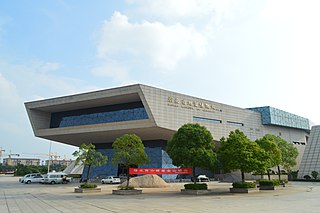
Hunan Museum of Geology is a geology museum located in Tianxin District, Changsha, Hunan, China. It is adjacent to the Hunan Youth Activity Center, Hunan Mass Art Museum, and Hunan Science and Technology Museum.

The Pokémon Fossil Museum is a travelling exhibition based on the Pokémon media franchise, displaying illustrations and "life-size" sculpted renditions of the skeletons of fossil Pokémon, along with the actual fossils of the real-life prehistoric animals and other organisms on which they were based. The exhibit was created by the National Museum of Nature and Science and The Pokémon Company.









